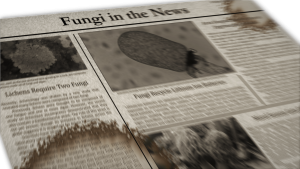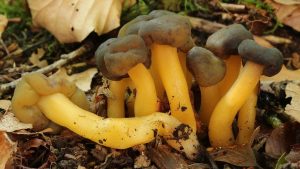#098: Psilocybin and Psilocin
These two toxins are the active chemicals in hallucinogenic mushrooms (often called “magic mushrooms” or “‘shrooms”). Psilocybin and psilocin belong to the LSD family of chemicals, but they are smaller than LSD and occur naturally in mushrooms. These compounds can be found in a variety o f mushrooms, including many species in the genera Psilocybe, Conocybe, Panaeolus, and Gymnopilus. Most often, the mushrooms eaten for their hallucinogenic effects belong to the genus Psilocybe, which lends its name to psilocybin and psilocin.
Psilocybin-containing mushrooms are usually eaten intentionally by people seeking a hallucinogenic experience. These mushrooms tend to have a bitter taste, so they are normally prepared in some food item to mask the bitterness. Symptoms appear in about 15 minutes after ingestion and generally come in two varieties, colloquially known as “good trips” and “bad trips.” Which of these an individual experiences depends upon the amount ingested, mood, personality, and health of the individual. Although symptoms of psilocin poisoning vary widely, the ones most commonly experienced during good trips include: changes in behavior and motor reflexes, altered perception, hallucinations, inability to tell the difference between fantasy and reality, changes in time perception, and out-of-body experiences. Bad trips include many of the same symptoms, but are characterized by anxiety, paranoia, and/or panic. Overdoses of psilocybin are possible and can result in very bad trips and even death.
Bad trips can cause long-term problems. Some users who experienced bad trips have reported flashbacks, impaired memory, and lifelong fear stemming from their experience. People who have struggled with mental illness should avoid all hallucinogens, including psilocybin and psilocin, because those drugs can trigger or exacerbate conditions such as depression, schizophrenia, and mania.
People will build up a tolerance to psilocybin with regular use, such that any amount of the toxin (or related toxins, such as LSD) can be ingested without hallucinogenic effects. However, this tolerance will fade after a period of abstinence, allowing people to use it periodically. Psilocybin does not cause addiction or dependence. Symptoms of psychological withdrawal can occur for a few days after ingestion of psilocybin, so users may have problems discerning fantasy from reality for some time.
Treatment of psilocybin poisoning focuses on easing symptoms. People experiencing bad trips can normally be soothed by a friend offering reassurance. In the event of a bad trip, a friend should get the user into a safe, comfortable place away from visual and auditory stimuli. If the user cannot be calmed down, the friend should get medical help for the user. Doctors can alleviate the symptoms using various drugs, including chlorpromazine to suppress hallucinations and diazepam to suppress muscle convulsions.
Psilocybin (chemical name: [3-[2-(dimethylamino)ethyl]-1H-indol-4-yl] dihydrogen phosphate) is a relatively small molecule based on a double ring structure. The main ring is composed of six carbon atoms with alternating single and double bonds (a benzene ring). In this configuration, each atom on the main ring can form a bond with one other atom. The first carbon in the ring is bound to a dihydrogen phosphate group (H2PO4). In other words, it is bound to an oxygen atom which is bound to a phosphorous atom which is bound to three more oxygen atoms. Two of the terminal oxygens are bound to hydrogen atoms and one is double-bound to the phosphorous atom. The second through fourth atoms in the main ring are each bound to one hydrogen atom. The last two main ring carbon atoms are bound to either end of a three-atom chain, which makes a secondary, five-atom ring: fifth main ring carbon—nitrogen—carbon A—carbon B—sixth main ring carbon. In the secondary ring, the nitrogen atom is bound to a hydrogen atom and single-bound to each adjacent carbon atom. Carbon A is bound also bound to a hydrogen atom and is double-bound to carbon B. Carbon B is also bound to a two-carbon chain where each carbon forms only single bonds and, in addition, is bound to two hydrogen atoms. The last carbon in this chain is bound to a nitrogen atom, which also binds two methyl groups (CH3).
Once in the body, psilocybin is dephosphorylated (the H2PO4 group is removed), turning it into psilocin. Psilocin (chemical name: 3-[2-(dimethylamino)ethyl]-1H-indol-4-ol) has exactly the same structure as psilocybin, except that it has an OH group attached to the first main ring carbon.
Psilocin acts by binding to serotonin receptors in the central nervous system. It is able to do this because its structure is very similar to that of the neurotransmitter serotonin. When psilocin binds serotonin receptors, it activates those neurons inappropriately, making it difficult for the brain to correctly process information. The result of this is hallucinations and altered perception of sight, sound, etc.
Most of the attention psilocybin/psilocin gets is due to its use as a recreational drug. It is classified as a Schedule I drug under the Controlled Substances Act of 1970. This was in response to the rise in popularity of hallucinogenic drugs (most notoriously, LSD) for recreational use during the 60’s and 70’s.
Long before that, psilocybin-containing mushrooms were used in the social and religious ceremonies of some Native Americans in what is today Mexico. In these rituals, hallucinogenic mushrooms called “god’s flesh” were used to produce hallucinations. These hallucinations would help people solve problems, treat illnesses, and contact spirits. Researchers originally became interested in these mushrooms after hearing about how they were used in those ceremonies. Psilocybin was first synthesized in the 1950’s. Following this, many trials of the drug’s uses were carried out during the early days of research into hallucinogens. In one of these trials, ten divinity students were given the drug on Good Friday and most reported having spiritual experiences (one did have a bad trip and had to be given antipsychotics). Timothy Leary was involved with some of these early psilocybin studies at Harvard before he moved on to LSD.
Of course, the hallucinogen craze became too much to handle, so psilocybin, LSD, and other such compounds were outlawed in the late 60’s. This made it very difficult for researchers to study the drugs, and almost no research was done on them for the next 30 to 40 years. Recently, however, this has started to change. Most of the research into hallucinogenic compounds in the 60’s focused on LSD, so modern researchers are trying to avoid that controversial compound by using psilocybin instead. A number of studies have come out recently suggesting that psilocybin can be used to help people relieve depression, anxiety, obsessive compulsion, and even cluster headaches. In the cluster headache study, psilocybin worked even though patients were given less than the amount required for a trip. One study reported that it gave terminal cancer patients an improved outlook on life and death. This study also noted that the effects of psilocybin continued for six months after the drug was administered. These studies make me hopeful that, with some more research, psilocybin has the potential to improve quality of life for many people.
See Further:
http://www.botany.hawaii.edu/faculty/wong/BOT135/Lect18.htm (see Group VII)
http://www.drugabuse.gov/publications/drugfacts/hallucinogens-lsd-peyote-psilocybin-pcp
http://www.cesar.umd.edu/cesar/drugs/psilocybin.asp
http://pubchem.ncbi.nlm.nih.gov/compound/Psilocybin#section=Top
http://pubchem.ncbi.nlm.nih.gov/compound/psilocin#section=Top
http://www.newyorker.com/magazine/2015/02/09/trip-treatment
http://www.nytimes.com/2014/11/30/opinion/sunday/can-mushrooms-treat-depression.html?_r=0
And do your own internet search for much more journalism on the potential uses of psilocybin.

![#085: Schizophyllum commune, the Mushroom With Over 28,000 Sexes [Archived]](https://www.fungusfactfriday.com/wp-content/themes/hueman/assets/front/img/thumb-medium-empty.png)





![#011: Characteristics of Kingdom Fungi [Archived]](https://www.fungusfactfriday.com/wp-content/themes/hueman/assets/front/img/thumb-small-empty.png)



I think this is an informative post and it is very useful and knowledgeable. therefore, I would like to thank you for the efforts you have made in writing this article.